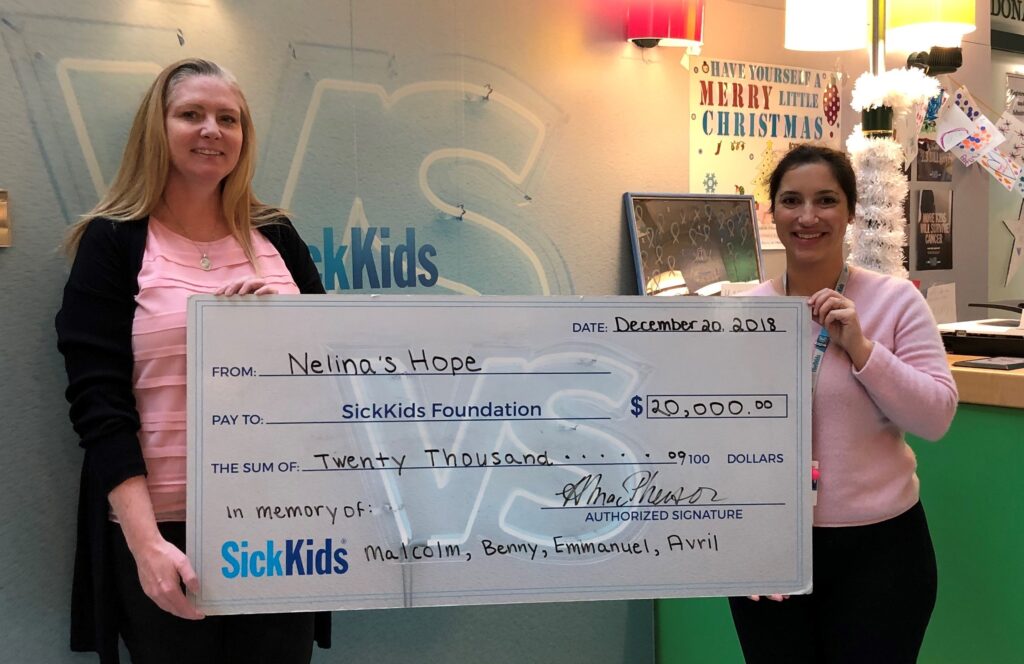
We are pleased to announce the 2018 Small Grant Recipient is Dr. Vijay Ramaswamy, a Junior PI and staff oncologist at SickKids Hospital in Toronto. The research project that this grant will support is Overcoming radiation resistance in high-risk pediatric brain tumors. The research will approach radiation resistance to determine which components of DNA Damage Response pathway are required for repair by radiation induced damage. Various approaches will be used in parallel using various drug inhibitors to determine if cells can become more sensitive to radiation treatment. The research will approach high risk brain tumors such as RELA fused supratentorial ependymoma followed by ATRT and DIPG.
This Gift of Hope was made in memory of Malcolm, Benny, Emmanuel and Nelina’s Step-grandmother, Avril Moore.
As provided by Sick Kids, the research proposal for Dr. Vijay Ramaswamy.
Overcoming radiation resistance in high-risk pediatric brain tumours
PI: Vijay Ramaswamy
Labatt Brain Tumour Research Centre/Programme in Developmental and Stem Cell Biology
Brain tumours represent the leading cause of cancer related death in children. Although recently many new therapies have been trialed based on a promising response in adult early phase studies, unfortunately in the past decade only one new agent has been approved for the treatment of brain
tumours in children (everolimus for subependymal giant cell astrocytoma). As such, despite tremendous advances in the genomics of pediatric brain tumours, survival has remained stagnant and the dream of personalized medicine for the vast majority of children has not materialized due
to a lack of genomic targets with available drugs. In light of this, radiation and non-specific chemotherapy remain for now the only treatments for almost all malignant pediatric brain tumours. Although radiation is not curative in most patients, the majority of tumours, including the most aggressive entities such as malignant embryonal tumors and glioma’s, still show clear objective responses to radiation, suggesting at least a proportion of cells are sensitive to treatment. As such, it is unlikely that radiation can be replaced in most patients. Unfortunately, those children that do survive, will have lifelong side effects of treatment necessitating new treatments across all pediatric brain tumours. Without new therapies on the immediate horizon, one avenue of innovative therapy is to try to improve the efficacy of radiation and chemotherapy. Normally, a cancer cells are multiplying constantly, but when there is DNA damage induced by
radiation, it stops dividing, arrests at the G2/M checkpoint and tries to repair the DNA before moving through mitosis. If the cell is able to successfully repair the DNA, then it continues to move through cell division, if it is unable to repair the DNA the cell dies. Normal brain cells are
not dividing, rendering them more resistant to radiation induced injury. Some adult cancers, such as breast cancer, have acquired mutations such as BRCA1 which lead the initial initiation of cancer. A strategy in breast cancer is to prevent the repair of DNA leading to cell death with agents such as PARP inhibitors, causing further DNA damage. However, these mutations are rarely if ever present in pediatric brain tumours.
We propose to approach radiation resistance, through a synthetic lethality screen, where we will determine which components of the DNA Damage Response pathway are required for repair of radiation induced damage. Using siRNA and CRISPR-Cas9 approaches, genes involved in the
DNA Damage Response pathway will be inhibited in very high-risk pediatric brain tumours and assessed for synthetic lethality with subtherapeutic doses of radiation (specifically a dose which does not normally cause cell death). Applying this unbiased approach, we will seek to identify
those genes essential for DNA repair in response to radiation, and then where available introduce a small molecule inhibitor of the same target. I have successfully applied this approach in very-high risk medulloblastoma, identifying ATR as a new and previously unidentified target for
therapy, and anticipate that we will identify entity specific selective vulnerabilities in response to DNA damage (ie. each brain tumour entity will need different components of the DNA damage response inhibited to cause this synthetic effect with radiation). A similar unbiased approach will
be undertaken in parallel using a drug library of 650 kinase inhibitors, in combination with a sublethal dose of radiation, to see if specific drugs can render cell more sensitive to radiation. We will apply this approach to high-risk RELA fused supratentorial ependymoma, followed by
ATRT and DIPG. This approach has the potential for rapid clinical translation, especially in those tumour types with the worst prognosis, and has the potential to perhaps reduce radiation doses in those tumour types with a good prognosis with radiation therapy.
Read more about other Gifts of Hope Research.